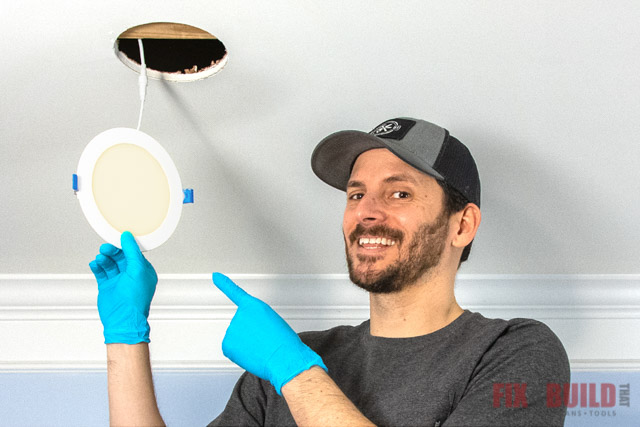
Illuminating Brilliance: A Step-by-Step Guide on How to Install LED Recessed Lighting in an Existing Ceiling
Introduction
LED recessed lighting is a modern and energy-efficient way to brighten up your living spaces. Installing these sleek fixtures in an existing ceiling might seem daunting, but with the right tools and a step-by-step approach, it can be a rewarding DIY project. In this comprehensive guide, we’ll delve into the process of installing LED recessed lighting, providing insights, tips, and answering frequently asked questions to ensure a successful lighting upgrade.
Table of Contents
- Understanding LED Recessed Lighting
- Assessing Your Existing Ceiling
- Gathering the Necessary Tools and Materials
- Choosing the Right LED Recessed Lights
- Planning the Layout
- Locating Electrical Wiring and Junction Boxes
- Cutting Access Holes in the Ceiling
- Wiring and Installing LED Recessed Lights
- Attaching and Securing the Lights
- Testing and Adjusting
- Common Mistakes to Avoid
- Safety Considerations
- Frequently Asked Questions (FAQs)
- Conclusion
1. Understanding LED Recessed Lighting
LED recessed lights, also known as can lights or downlights, are fixtures installed into the ceiling to provide ambient or focused illumination. LED technology offers energy efficiency, a longer lifespan, and the flexibility to customize the color temperature of the light.
2. Assessing Your Existing Ceiling
Before diving into the installation process, assess your existing ceiling to determine its type, material, and any potential obstacles such as wiring, plumbing, or structural components. Understanding your ceiling’s composition will inform your approach to installing recessed lighting.
3. Gathering the Necessary Tools and Materials
Ensure you have the following tools and materials ready:
- LED recessed lights
- Power drill with hole saw attachment
- Fish tape or coat hanger
- Voltage tester
- Wire stripper
- Screwdriver
- Cable connectors
- Wire nuts
- Ceiling patch kit
- Drywall saw
4. Choosing the Right LED Recessed Lights
Select LED recessed lights that fit your design preferences and lighting needs. Consider factors such as color temperature, brightness (measured in lumens), and the size of the fixtures. Choose fixtures that are suitable for retrofitting into existing ceilings.
5. Planning the Layout
Determine the placement of your recessed lights by considering the room’s layout and function. Aim for even illumination with spacing that complements the size of the room. Use a pencil to mark the locations of each light on the ceiling.
6. Locating Electrical Wiring and Junction Boxes
Identify the location of electrical wiring and junction boxes in your ceiling. Ensure there is enough capacity to add new fixtures. If uncertain, consult with a licensed electrician to assess and make any necessary upgrades.
7. Cutting Access Holes in the Ceiling
Using a power drill with a hole saw attachment, carefully cut access holes for the recessed lights. Follow the markings you made during the layout planning. Take caution to avoid any existing wiring or structural elements.
8. Wiring and Installing LED Recessed Lights
8.1 Turn off Power
Before starting the wiring, turn off the power to the lighting circuit at the circuit breaker. Use a voltage tester to ensure the power is off before proceeding.
8.2 Connect Wiring
Run electrical wiring from the existing junction box to each recessed light location. Use cable connectors to secure the wiring. Connect the black wires to black wires and white wires to white wires, using wire nuts.
8.3 Secure Fixtures
Secure each LED recessed light into its designated hole by attaching the provided clips or brackets to the ceiling. Follow the manufacturer’s instructions for your specific fixtures.
9. Attaching and Securing the Lights
Secure the lights in place by following the manufacturer’s instructions for your specific fixtures. This may involve adjusting the clips, springs, or brackets provided with the lights. Ensure a snug fit to the ceiling to create a seamless appearance.
10. Testing and Adjusting
Once the lights are installed, turn the power back on and test each light individually. Ensure they illuminate properly and adjust the trim or lens if needed to achieve the desired lighting effect. Make any necessary adjustments to achieve uniform illumination.
11. Common Mistakes to Avoid
11.1 Skipping Safety Precautions
Always turn off the power at the circuit breaker before working with electrical wiring. Use a voltage tester to verify that the power is off before proceeding.
11.2 Ignoring Load Capacity
Ensure that the existing electrical wiring and junction boxes can handle the additional load from the new LED recessed lights. Upgrading wiring or consulting with an electrician may be necessary.
12. Safety Considerations
- Turn off Power: Always turn off the power at the circuit breaker before working with electrical components.
- Use Caution with Tools: Exercise caution when using power tools, especially when cutting into the ceiling. Follow safety guidelines for each tool.
- Check Wiring: Before making any electrical connections, verify that the wiring is in good condition and capable of handling the additional load.
13. Frequently Asked Questions (FAQs)
1: Can LED recessed lights be installed in any ceiling type?
LED recessed lights can be installed in various ceiling types, including drywall, plaster, and drop ceilings. However, the installation process may vary based on the ceiling’s composition.
2: How many LED recessed lights do I need for a room?
The number of lights depends on the size and function of the room. As a general guideline, aim for 6-8 feet between lights for general lighting and closer spacing for task lighting.
3: Can I install LED recessed lights myself?
With the right tools and knowledge, installing LED recessed lights can be a DIY project. However, if you’re uncertain about electrical work, consulting with a licensed electrician is advisable.
4: Can LED recessed lights be dimmed?
Many LED recessed lights are compatible with dimmer switches. Ensure that both the fixtures and dimmer switch are designed for dimming capabilities.
5: What is the lifespan of LED recessed lights?
LED recessed lights typically have a longer lifespan than traditional lighting options, often lasting 25,000 to 50,000 hours or more.
6: Do LED recessed lights generate heat?
LED recessed lights generate significantly less heat compared to traditional incandescent bulbs. They are energy-efficient and produce minimal heat output.
7: Can I install LED recessed lights in a bathroom?
Yes, many LED recessed lights are suitable for bathrooms, but ensure they are rated for wet or damp locations. Check the manufacturer’s specifications for compatibility.
8: Are LED recessed lights energy-efficient?
Yes, LED recessed lights are highly energy-efficient. They consume less power and have a longer lifespan, making them a sustainable lighting option.
9: What is the difference between retrofit and new construction LED recessed lights?
Retrofit fixtures are designed to be installed into existing ceilings without requiring major modifications. New construction fixtures are intended for installation in new ceilings or during significant renovations.
10: Can LED recessed lights be installed in sloped ceilings?
Yes, there are LED recessed lights specifically designed for sloped ceilings. These fixtures come with adjustable trims to accommodate the angle of the ceiling.
14. Conclusion
Installing LED recessed lighting in an existing ceiling is a project that can enhance the ambiance and functionality of your living spaces. By understanding the steps involved, prioritizing safety, and selecting the right fixtures for your needs, you can successfully upgrade your lighting and bring a touch of modernity to your home. Whether you choose to embark on this journey as a DIY enthusiast or seek professional assistance, the result will be a well-lit space that complements your lifestyle and adds a touch of brilliance to your home.

